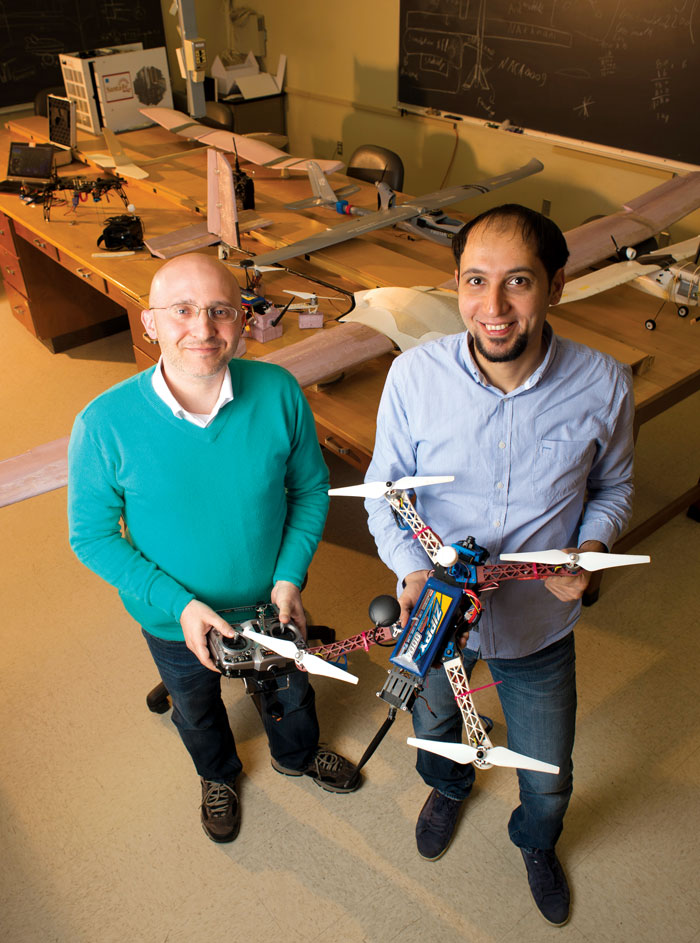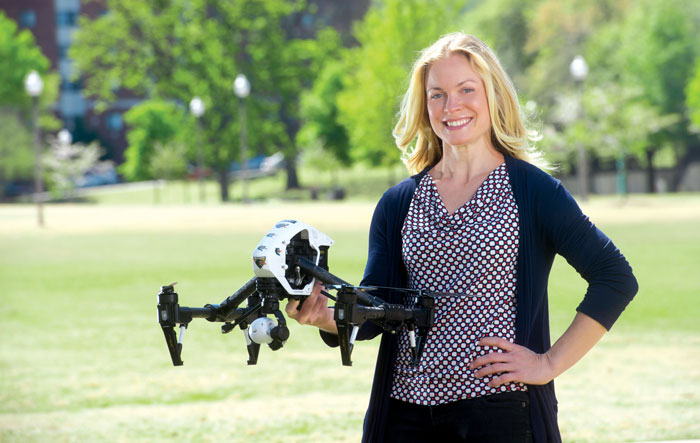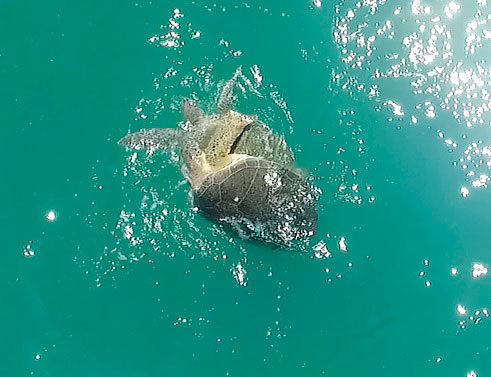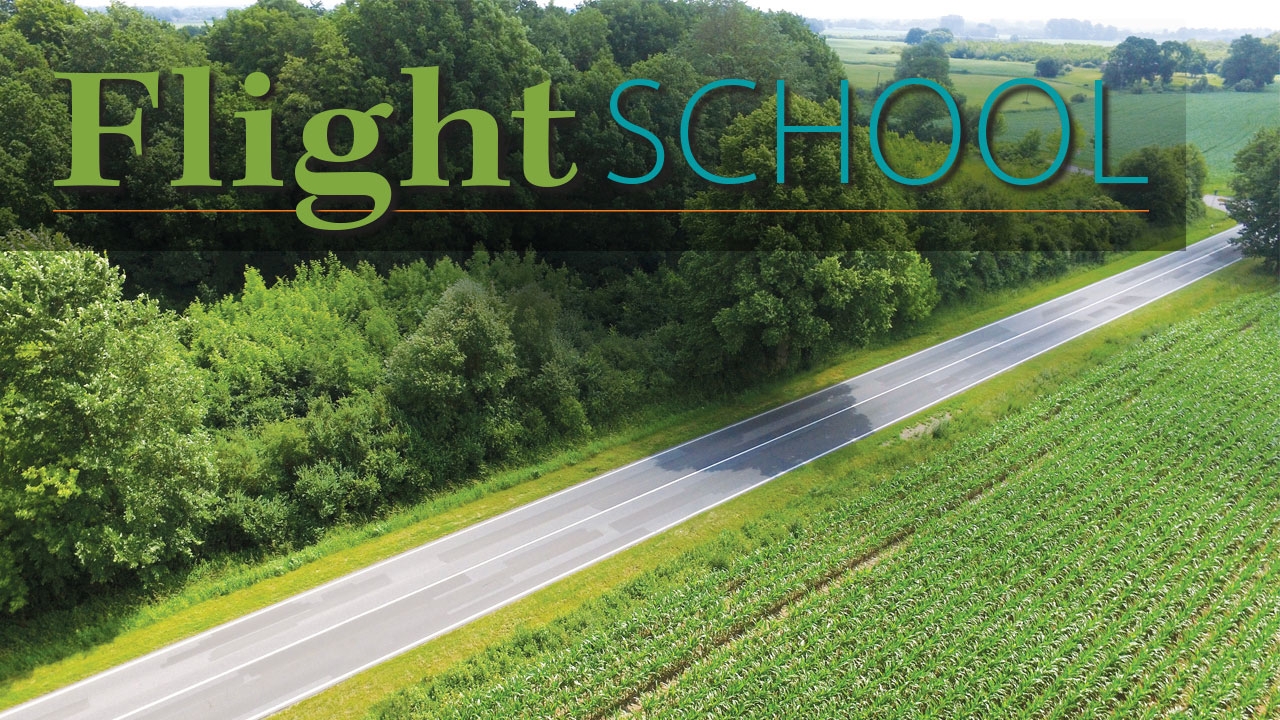Students chart new courses for drones
By Matt Windsor • Photos by Steve Wood
Unmanned aerial vehicles—UAVs or drones—seem to be everywhere these days, both in the air and in the news. Plane-sized military drones play a controversial role in the Middle East. Amazon and Walmart are eyeing them as delivery vehicles. And photographers rely on them to capture the perfect shot or video from dizzying vantage points.
But beyond the narrative of drones as airborne cameras, killers, or beasts of burden, UAB students are inventing new uses for UAVs—employing them to reveal nature’s secrets and even save lives.
 Arie Nakhmani (left) and Ali Darwish (right) with one of their drones
Arie Nakhmani (left) and Ali Darwish (right) with one of their dronesA Lifeline From Above
Ali Darwish, a doctoral student in the Department of Electrical and Computer Engineering, admits that many people are afraid of drones. That’s unfortunate, he says, because the inexpensive flying machines can be useful for everyone, from farmers inspecting crops to safety engineers looking for problems to humanitarian agencies assisting people in need.
Working in the lab of computer vision expert Arie Nakhmani, Ph.D., an assistant professor of electrical and computer engineering, Darwish is pursuing a doctoral thesis project to use eye-tracking software to diagnose Parkinson’s disease. But his real labor of love is a frail-looking aircraft sprawled over several lab benches. Built from recycled golf clubs and insulation foam, it is packed with advanced electronics and guidance algorithms. The drone’s purpose is to ferry medicines and other supplies, up to several pounds’ worth, for hundreds of miles. That would let it deliver medical aid to refugee camps or disaster victims. The inexpensive materials that make up the contraption are likely to be on hand in low-resource settings around the world, Darwish says. He bought the busted graphite golf clubs for the fuselage for a dollar apiece from a local country club.
The real trick is to program the computer that flies the plane, which is entirely autonomous, requiring no human input once its course is set and it is launched. To make the motor’s battery last for a round-trip flight of several hundred miles, Darwish uses machine-learning techniques to teach his computer to constantly shift between powered flight and gliding. It must take into account endless changes in wind currents and other conditions in order to travel the most efficient course.
The project, which includes collaborators at the University of Alabama in Huntsville and Stanford University, was inspired by the suffering seen in Syria, Darwish says. When the marathon drones are ready for real-world action, the team plans to make the design freely available.
 Elizabeth Bevan (above) records little-known mating behaviors of Kemp’s ridley sea turtles in the Gulf of Mexico (below).
Elizabeth Bevan (above) records little-known mating behaviors of Kemp’s ridley sea turtles in the Gulf of Mexico (below). Beyond saving lives, drones have plenty of untapped commercial potential, Darwish adds. He and other UAB students are building a craft equipped with infrared cameras and ultrasound sensors that could remotely inspect dams and other key infrastructure—a concept that recently scored a top prize in a global engineering competition. Darwish also has launched a start-up company, Exponential Drones, with an eye to exploring new business opportunities among the clouds. “There are so many applications of this technology,” he says.
(Read more about Darwish's work on the UAB Mix.)Wildlife Watchers
Like Darwish, Elizabeth Bevan uses drones to reach places she can’t. In her case, that is a handful of miles offshore in the Gulf of Mexico.
Bevan, a doctoral student in the Department of Biology, studies the effects of climate change on the endangered Kemp’s ridley sea turtle. She focuses on understanding the courtship and mating behaviors of the turtles. The trouble is, no one really knows what these behaviors are, or where they happen. The only research on the subject is decades old, conducted in other species, and, because of logistical limitations, done mostly in captivity.
But in a recent paper, Bevan and her mentor, biology professor Thane Wibbels, Ph.D., documented eight different types of courtship and mating behavior—including one previously unknown—among the turtles in the Gulf. Her secret weapon: the DJI Inspire 1, a commercially available quadcopter with a high-resolution camera that allows her to observe turtle behavior without interfering with the animals. “Turtles don’t hear the same way we do,” Bevan says. “Every indication we have is that the drone doesn’t bother them.”
Bevan and Wibbels are now experimenting with new cameras, including a thermal imager that lets them track turtles in the ocean and on their nesting beaches through body heat. The UAB team has already flown over nesting mothers to get an unprecedented look at the process. “No one else has observed nesting from this perspective,” says Bevan.
 The drone’s thermal camera captures a turtle’s movement from her beach nest to the water. The green shape toward the image’s left side is the turtle, with her tracks visible behind her.
The drone’s thermal camera captures a turtle’s movement from her beach nest to the water. The green shape toward the image’s left side is the turtle, with her tracks visible behind her.During this year’s nesting season at their research location in Rancho Nuevo, Mexico, the researchers are hoping to film an
arribada, when thousands of Kemp’s ridley turtles swarm the beach within a few hours to lay their eggs. “Drone technology is revolutionizing the way we conduct biological studies of sea turtles and wildlife in general,” Bevan says. “This is giving us new ways to look at age-old questions.”
(Read more about Bevan's research on the UAB Mix.)Recently she—along with Darwish—shared some of her findings with the community through Discoveries in the Making, a UAB Graduate School program that encourages students to discuss their research at local libraries. “There are a lot of misconceptions about drones,” Bevan says. “I wanted to show an example of some of the incredible capabilities that this technology can provide.”
A Flying Ethics Problem?
In January 2016, the Federal Aviation Administration launched its Small Unmanned Aircraft System registry for aircraft weighing between 0.55 pounds and 55 pounds, which includes almost all consumer drones. But that isn’t likely to end debates in courts and coffee shops over the appropriate uses of UAVs.
“Emerging technologies, because they change what we’re able to do, generate new contexts for legal and ethical principles,” says Matt King, Ph.D., assistant professor in the UAB College of Arts and Sciences Department of Philosophy. He specializes in philosophy of law, a field examining the underlying principles of legal systems.
With drones, “morally and legally,” privacy is a main concern, King says. But many questions have clear analogues to existing technology. “We’re used to having our pictures taken by ATM cameras, closed-circuit cameras, and more,” King says. “When you’re in public, you don’t have the same protections or privacy as you do in private. Lots of drone use won’t be different than someone walking around a park taking pictures with a traditional camera.”
A larger concern “is the collateral information that is collected,” King adds. Imagine a user taking an aerial video of his or her neighborhood that captures activity in a wide swath of backyards, he says. “Those are areas where we expect a greater degree of privacy. I doubt there is much that could get you in trouble legally in that instance, but there are certainly moral concerns.”
Liability in the event of a crash is another issue. The area of the law concerned is tort law. “At its simplest, this is a set of obligations to be careful so that people don’t cause harm to each other,” King says. If you fly a drone over a crowd at a concert and it injures someone, for instance, you could well be legally liable, he explains.
“There is a constant balancing act between engaging in activities that we’re at liberty to do but that carry risk to others,” King says.
Published October 2016
 Arie Nakhmani (left) and Ali Darwish (right) with one of their drones
Arie Nakhmani (left) and Ali Darwish (right) with one of their drones Elizabeth Bevan (above) records little-known mating behaviors of Kemp’s ridley sea turtles in the Gulf of Mexico (below).
Elizabeth Bevan (above) records little-known mating behaviors of Kemp’s ridley sea turtles in the Gulf of Mexico (below). 
 The drone’s thermal camera captures a turtle’s movement from her beach nest to the water. The green shape toward the image’s left side is the turtle, with her tracks visible behind her.
The drone’s thermal camera captures a turtle’s movement from her beach nest to the water. The green shape toward the image’s left side is the turtle, with her tracks visible behind her.

